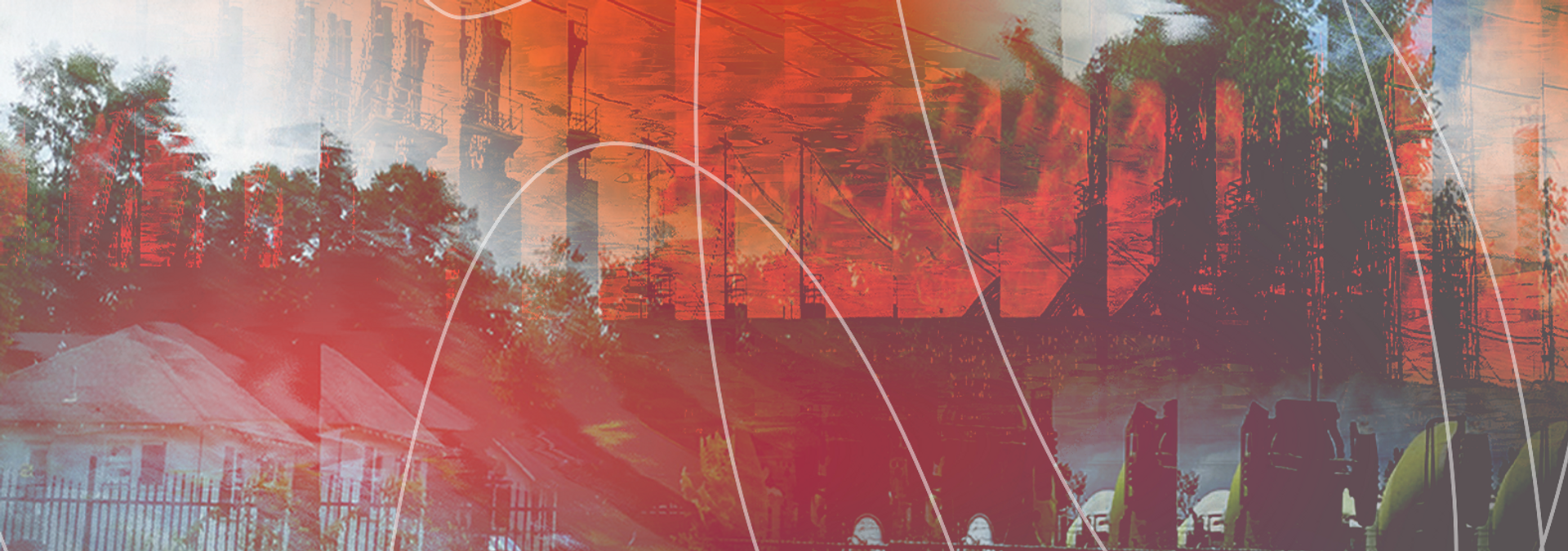
Why doesn't Texas prevent the concrete plants from coming into your community?
The Texas Commission on Environmental Quality's 'rubber-stamping' approach to permits makes it nearly impossible for communities to intervene and stand up for their health and safety. Photo illustration: Evan O'Neil.
Midlothian, Texas, Laura Hunt says, “is a fairly idyllic small town,” only about half an hour away from the highrises and art museums in downtown Dallas and Fort Worth. When her family settled on the south side of their new city in 2014, though, they couldn’t miss the three hulking cement kilns that form a triangle around it.
But as long as she couldn’t see them from their new home, she didn’t mind, she remembers telling her realtor at the time. They were about two miles away from the Martin Marietta cement plant — formerly owned by TXI Operations — that produces cement, an ingredient for the ubiquitous concrete used for new roads and sidewalks and foundations around the DFW metroplex and beyond. “We saw them as an eyesore,” she says. “But in this day and age, it never dawned on me that there wouldn’t be a million protections, and that it would be a health hazard to be in close proximity.”
There are three major cement plants in Midlothian that produce millions of tons of the stuff. In the process — which involves crushing limestone, clay or shale and then heating it in one of those kilns to extreme temperatures — they release tons of dust and fine particles that can be dangerous when breathed in. Fine particle pollution has been linked to decreased lung function, heart attacks and premature death. Hunt's daughter developed respiratory issues shortly after they moved to Midlothian, and Hunt, a pediatrician, suspects that environmental factors are to blame.
Two years before, in 2012, in fact, the Center for Disease Control and Prevention released a report in partnership with the Texas Department of State Health Services concluding that, as far back as the 1990s, Midlothian’s industrial facilities were producing enough pollution to cause lung and heart disease, particularly among residents living closest to the plants. But the Texas Commission on Environmental Quality told the Dallas Morning News there was nothing wrong with the air.
Midlothian may have once been dubbed the unofficial cement capital of the state, but the plants — along with concrete batch plants, which feed the lumpy gray slurry to diesel-powered mixer trucks around the clock — plagued communities all across rapidly growing Texas. In unincorporated communities in the Hill Country, batch plants have popped up next to rural residents’ homes, bringing heavy truck traffic and air pollution to their doorsteps. In Houston, where the protections of zoning laws do not exist, more than half of these plants are located in Black and Hispanic communities that tend to be already saturated with other sources of pollution. For both, the lack of city and county ordinances can’t stop the plants from being built if TCEQ approves the permits — and the agency almost always does.
Sometimes, these plants pop up without so much as a warning. They aren’t always required to post public notices about the air pollution permits they seek, depending on the type. That means community members like Hunt have to take it upon themselves to figure out why plants are seeking new permits so close to their homes and what they’re planning on pumping into the air. They have to know how to ask the state for public meetings, and they also have to have the resources to hire environmental consultants or lawyers to review the complicated permits for any inaccuracies and omissions. And all that a company has to do is make sure the paperwork is done.
The burden of proof
Some 30 miles northeast of Midlothian, residents of West Dallas, a predominantly Hispanic community, have been exposed to generations of pollution by city policies that allowed industrial facilities like a lead smelter to operate nearby.
West Dallas is also a community that knows how to fight: It was only due to decades of their activism that the smelter was shut down, and the federal government established a Superfund site in the 1990s to clean up the contamination. They recently pushed to get two concrete batch plants that were violating their permits shut down, says Raul Reyes, the director of West Dallas One. “One of the frustrations we have is that it feels like the burden of proof is on the community,” he says. “Why do we have to prove this, when there’s data that TCEQ is supposed to be monitoring?”
This is the third in a series of stories set across Texas about the ways TCEQ can change to work for our communities. Read the first about air monitoring in Port Arthur here and the second about enforcement in Houston here.
Still zoned for industrial use, despite the homes, businesses and churches here and residents’ ongoing fight for cleaner air and better amenities, West Dallas has remained a hub for the construction of new facilities. Residents are left searching for information about permits, Reyes says. “Usually, we’ll find them in a newspaper that isn’t utilized — that’s something that is a luxury we can’t afford, to get the newspaper every day.”
By the time residents are wondering who approved yet another polluting facility blocks away from their home, it’s far too late.
Reyes has traveled to Austin during legislative sessions to testify in favor of bills filed by lawmakers like Armando Walle and Senfronia Thompson that would strengthen the permitting process for concrete batch plants. But year after year, the legislature has failed to act. They’ve let the bills that would have regulated the dust and noise pollution die in committee. “It’ll be maybe three citizens who take up the mantle,” Reyes says of the committee hearings at the State Capitol. “But the [lobbyists], they fill up the room. And they’re the ones doing all the talking and spitting data in their suits.”
Who’s an ‘affected person’?
If it were up to anyone who lives near them, concrete and cement plants, whose owners claim they need to be near the construction sites in growing cities, would never be permitted to be sited so close to homes to begin with.
But when residents have to fight back, it’s incredibly difficult to intervene, says Adrian Shelley, the executive director of Public Citizen in Texas. Not everyone has the free time to learn how to read permits and build awareness in their communities, not to mention pay legal and consultation fees. “TCEQ takes the position that it can’t deny a permit that is administratively and technically complete,” Shelley says, so it’s on residents who are volunteering to prove otherwise, even if it’s obvious that a new concrete batch plant or more emissions at a cement facility could threaten public health.
TCEQ also approves each permit as though plants operate on paper, as they say they will, and not in the real world, ignoring how fine particles and noxious diesel exhaust can mix and compound with other pollution from a freeway or a salvage yard in people’s bodies over time. “The permitting system misses the impact in communities,” Shelley says. “It’s a singular look at the neighboring conditions.”
It’s no wonder that West Dallas One and Midlothian residents have expressed their frustrations directly to the state with what’s permitted — and how. “In cities like Dallas, and throughout the South, there’s a history of racism, putting polluters in communities of color,” Reyes says, noting that that history needs to be taken into account. “Within TCEQ’s mandate, there’s certain things that are incongruent. You can’t be looking out for economic development and the communities, because they don’t align.”
Hunt describes her experience challenging cement plant permits and attending public meetings as “infuriating, frustrating and discouraging.” She says that TCEQ’s Office of Public Interest Council needs to be strengthened, so that communities have a meaningful avenue of engagement in a language that they prefer to use. “It just seems like it’s a rubber-stamping process,” she says. “There’s a requirement to offer a public hearing, but it’s just to check a box. They’re not looking for meaningful participation.
When Hunt and other Midlothian residents petitioned for a contested case hearing against Holcim, the office recommended approving their request. Later that same day, though, the Executive Director’s office ruled that the residents didn’t qualify as “affected persons” because they didn't live close enough to the facility’s kilns. Last April, Holcim’s permit was approved, doubling the amount of carbon monoxide it could emit and allowing it to start burning pet coke, a petroleum byproduct.
In Houston, residents in Aldine are fighting a permit, too. A company is asking the state to let them build a concrete batch plant near a brand-new Harris County park designed for people with disabilities. It’s as though residents are being expected to repeat themselves all over again: Shouldn’t TCEQ, currently going through a performance evaluation known in Texas as a sunset review, be able to deny a permit for a plant where there are “more than half a dozen already,” as the executive director of the management district told Houston Public Media? Couldn’t TCEQ just make the permits stronger to begin with, so the levels of pollution that are allowed come with an adequate margin of safety even for people in so-called “sensitive groups” who already have respiratory issues? Couldn’t they extend the distance between the plant and residents’ homes much farther than the 400-meter dash that’s now the requirement? The agency ought to be able to do any and all of these things, but they don’t — or they haven’t yet.
Years ago, when her daughter first got sick, Hunt never saw herself as the activist type, even as she turned to groups like Downwinders at Risk for answers that weren’t readily available from TCEQ. “I had shied away from getting involved because I saw [environmentalists] as the kind of groups that stand around with picket signs and collectively hell-raise,” she says. “And that’s not me, or my personality.”
But three years later, Hunt is still in the thick of it, advocating for cleaner air in her community and educating other residents on TCEQ’s red-tape-laden processes. Hunt’s daughter was able to recover from the extreme symptoms she felt as a toddler, but still suffers from asthma and allergic reactions frequently. Specialists from across the country still haven’t been able to pinpoint the cause. Hunt worries about the children at soccer practices and track meets when pollution could be spiking from the cement kilns with no warning, no awareness. “We shouldn’t have to be playing the victims,” she says, begging for help from TCEQ. “Can’t we make things more protective to begin with?”
Ahmed is a freelance environmental reporter based in Dallas, Texas. Her work focusing on environmental justice has been published in the Texas Observer, Texas Monthly, Southerly and other outlets. You can find her on Twitter @amalahmed214.
STAY UP TO DATE
The quality of our newsletter is considered satisfactory and poses little or no risk.
SUBSCRIBE

